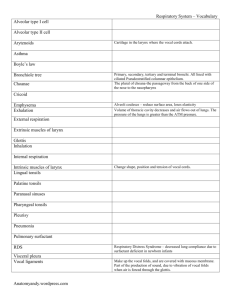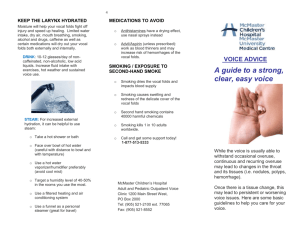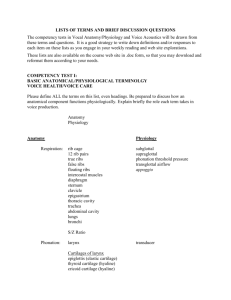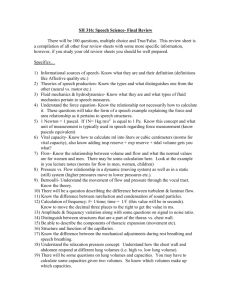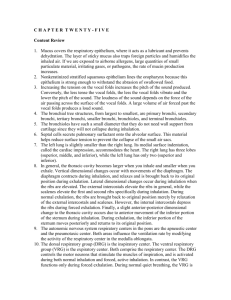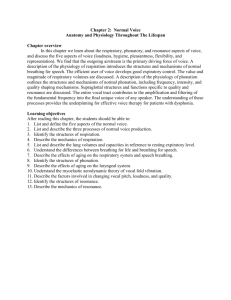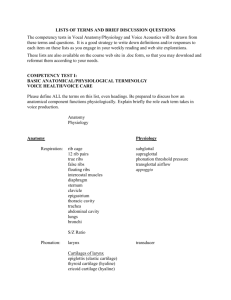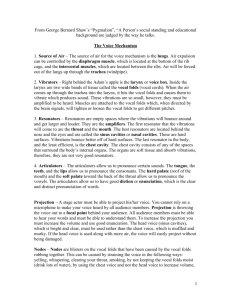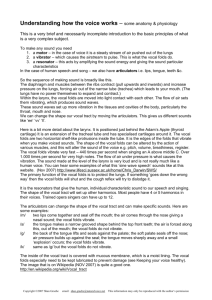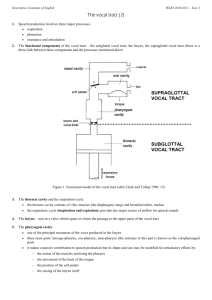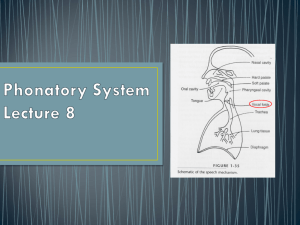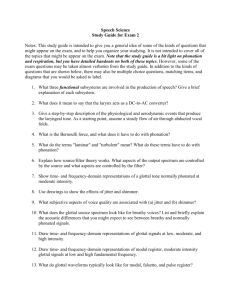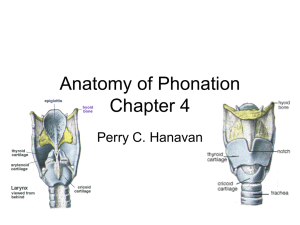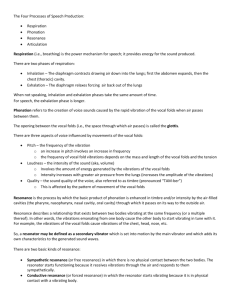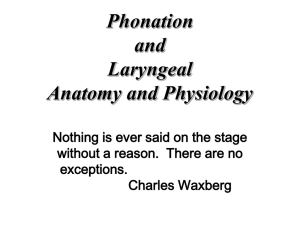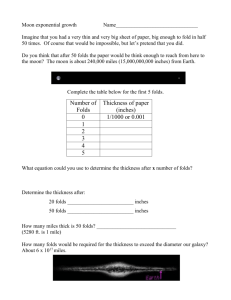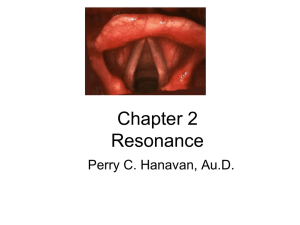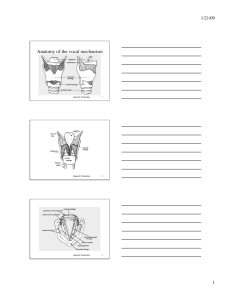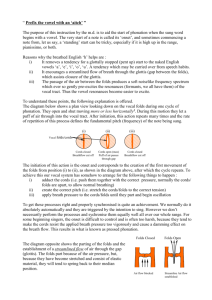Test Bank Chapter 2: Normal Voice Anatomy and Physiology
advertisement
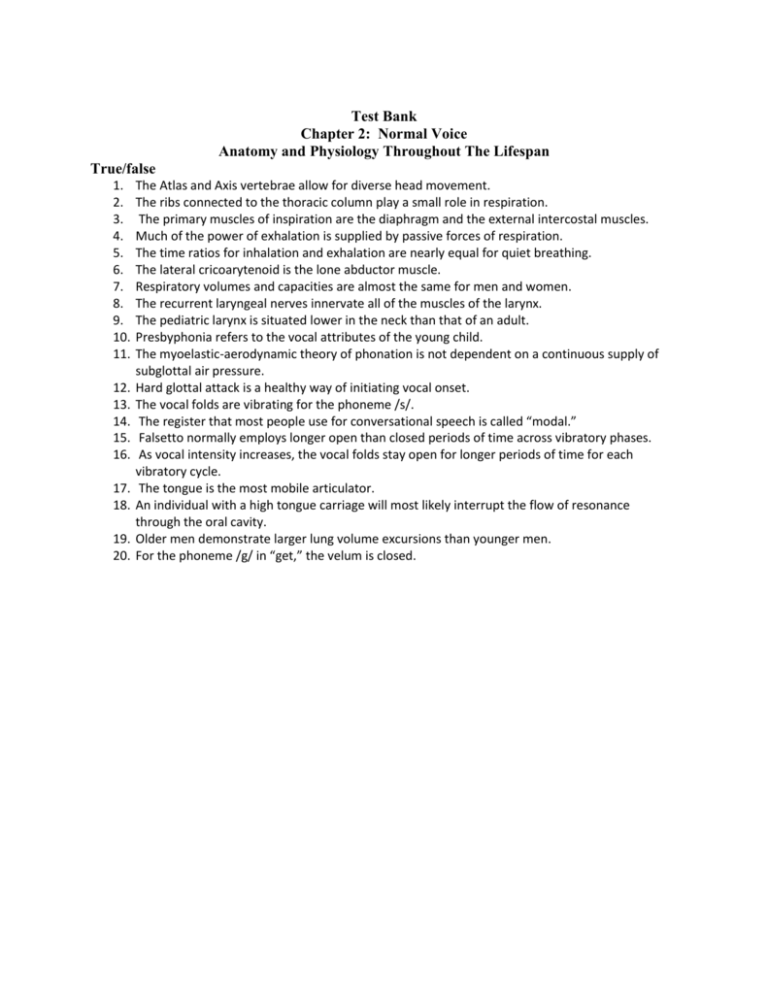
Test Bank Chapter 2: Normal Voice Anatomy and Physiology Throughout The Lifespan True/false 1. 2. 3. 4. 5. 6. 7. 8. 9. 10. 11. 12. 13. 14. 15. 16. 17. 18. 19. 20. The Atlas and Axis vertebrae allow for diverse head movement. The ribs connected to the thoracic column play a small role in respiration. The primary muscles of inspiration are the diaphragm and the external intercostal muscles. Much of the power of exhalation is supplied by passive forces of respiration. The time ratios for inhalation and exhalation are nearly equal for quiet breathing. The lateral cricoarytenoid is the lone abductor muscle. Respiratory volumes and capacities are almost the same for men and women. The recurrent laryngeal nerves innervate all of the muscles of the larynx. The pediatric larynx is situated lower in the neck than that of an adult. Presbyphonia refers to the vocal attributes of the young child. The myoelastic-aerodynamic theory of phonation is not dependent on a continuous supply of subglottal air pressure. Hard glottal attack is a healthy way of initiating vocal onset. The vocal folds are vibrating for the phoneme /s/. The register that most people use for conversational speech is called “modal.” Falsetto normally employs longer open than closed periods of time across vibratory phases. As vocal intensity increases, the vocal folds stay open for longer periods of time for each vibratory cycle. The tongue is the most mobile articulator. An individual with a high tongue carriage will most likely interrupt the flow of resonance through the oral cavity. Older men demonstrate larger lung volume excursions than younger men. For the phoneme /g/ in “get,” the velum is closed. Multiple choice 1. The largest of the vertebrae are the a. cervical b. thoracic c. lumbar d. coccyx 2. The bifurcation of the trachea at the level of the fifth thoracic vertebra is known as the a. pleural membrane b. alveoli c. carina d. plural duct 3. When the thorax enlarges, the a. lungs contract and exhalation begins b. lungs enlarge and exhalation begins c. lungs contract and inhalation begins d. lungs enlarge and inhalation begins 4. Most voice disordered patients who report that they run out of air when speaking would benefit from a. respiratory training exercises b. speaking at high lung volumes c. focusing on taking breaths at appropriate places in a phrase d. speaking at low lung volumes 5. The reduced ability of the larynx to be palpated from side to side may be indicative of a. degenerative changes b. the presence of a mass c. muscle tension dysphonia d. all the above 6. Contraction of the interarytenoid muscles serve to a. draw the arytenoids together b. decrease the distance between the cricoid and thyroid cartilages c. tilt the thyroid cartilage superiorly d. pull the arytenoids apart 7. The true vocal folds are lubricated by a. sacs found in the ventricles b. glands found on the ventricular folds c. the rima glottis d. a and b 8. The mucosal wave a. is comprised of the intermediate layer of the lamina propria b. may be interrupted due to a space occupying lesion or edema c. can be seen by the naked eye d. is adhered tightly to the vocal ligament 9. When vocal folds lengthen, pitch normally ____________ due to contraction of the __________________ muscles. a. increases, cricothyroid b. decreases, thyromuscularis c. remains the same, thyroarytenoid d. increases, interarytenoid 10. The movement and positioning of the velum changes the size and shape of a. the pharynx b. the oral cavity c. the nasal cavity d. all the above Key to Chapter 2 Test Bank questions True/false 1. 2. 3. 4. 5. 6. 7. 8. 9. 10. 11. 12. 13. 14. 15. 16. 17. 18. 19. 20. T F T T T F F F F F F F F T T F T T T T Multiple choice 1. 2. 3. 4. 5. 6. 7. 8. 9. 10. C C D C D A D B A D A. B. C. D. E. F. G. H. I. J. K. L. M. N. O. P. Q. True vocal folds Ventricular space Ventricular folds Epiglottis Aryepiglottic folds Hypopharynx Inferior pharyngeal constrictors and upper esophageal sphincter Middle pharyngeal constrictors Valleculae Oropharynx Mandible Tongue Passavant’s pad Soft palate Hard palate Nasopharynx Nasal cavity
